Genre Analysis and Research Report: Neonatal Health Study Review
VerifiedAdded on 2021/06/14
|12
|3336
|20
Report
AI Summary
This report provides a comprehensive analysis of a research article focusing on reproductive epidemiology and neonatal health, specifically examining the impact of vitrified embryo transfer on birth outcomes. The study, conducted at the Centre for Reproductive Medicine of the university hospital UZ Brussels, analyzed data from 1072 children, including variables such as birth weight, gestational age, and congenital malformation rates. The methodology involved descriptive statistics, Pearson correlation coefficients, Chi-square tests, and Student’s t-tests to compare outcomes between singletons and twins, as well as those born after vitrified and fresh embryo transfers. The report critically evaluates the study's design, data collection methods, statistical analysis, and clinical significance, highlighting limitations such as the small twin group and the potential for bias. The results suggest that vitrified embryo transfer does not adversely affect neonatal health, with favorable outcomes observed for singletons. The report emphasizes the importance of the study's findings for future research and clinical practice, while also acknowledging the need for cautious interpretation due to certain limitations.

Genre Analysis and Research
Paraphrase This Document
Need a fresh take? Get an instant paraphrase of this document with our AI Paraphraser
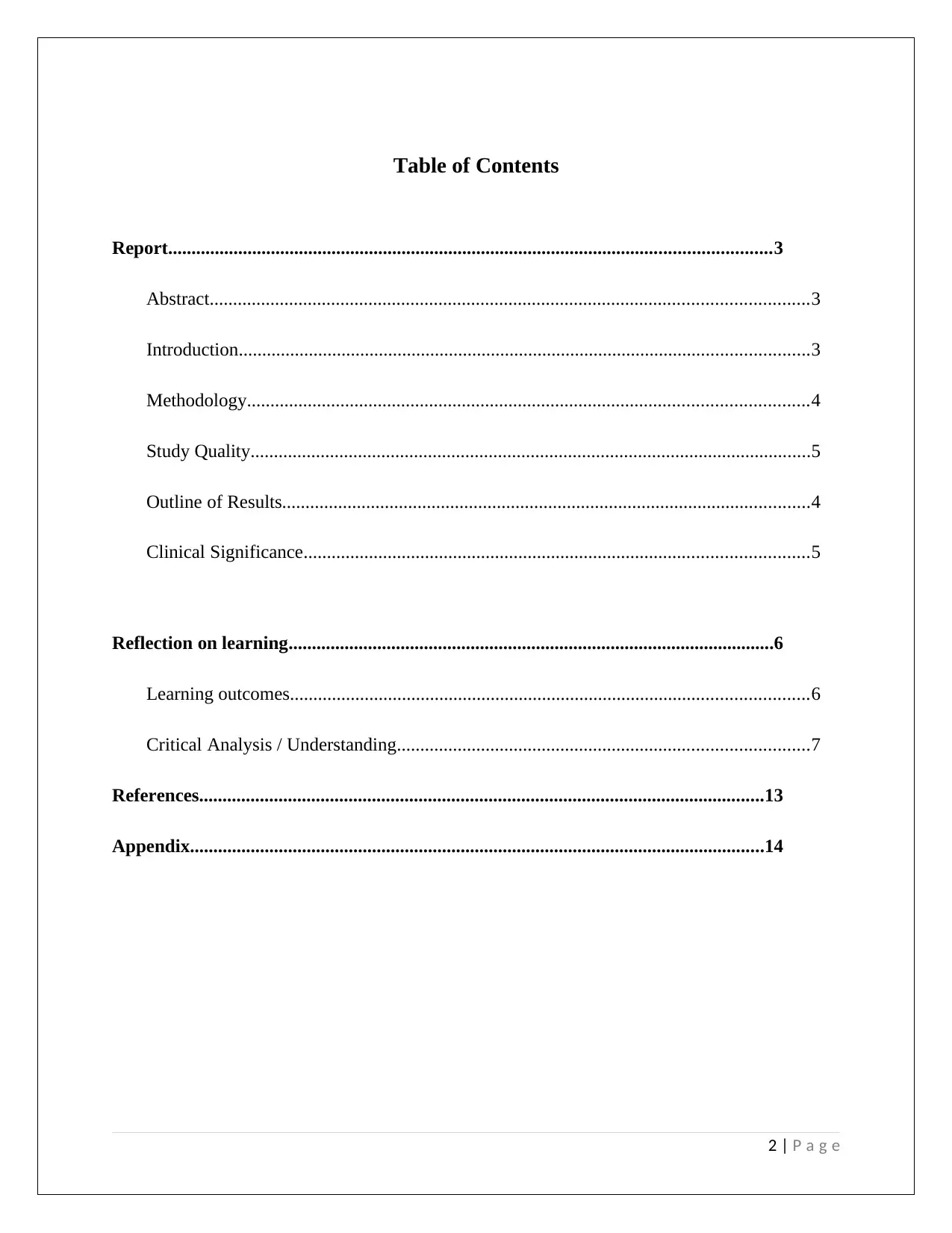
Table of Contents
Report.................................................................................................................................3
Abstract................................................................................................................................3
Introduction..........................................................................................................................3
Methodology........................................................................................................................4
Study Quality........................................................................................................................5
Outline of Results.................................................................................................................4
Clinical Significance............................................................................................................5
Reflection on learning........................................................................................................6
Learning outcomes...............................................................................................................6
Critical Analysis / Understanding........................................................................................7
References.........................................................................................................................13
Appendix...........................................................................................................................14
2 | P a g e
Report.................................................................................................................................3
Abstract................................................................................................................................3
Introduction..........................................................................................................................3
Methodology........................................................................................................................4
Study Quality........................................................................................................................5
Outline of Results.................................................................................................................4
Clinical Significance............................................................................................................5
Reflection on learning........................................................................................................6
Learning outcomes...............................................................................................................6
Critical Analysis / Understanding........................................................................................7
References.........................................................................................................................13
Appendix...........................................................................................................................14
2 | P a g e
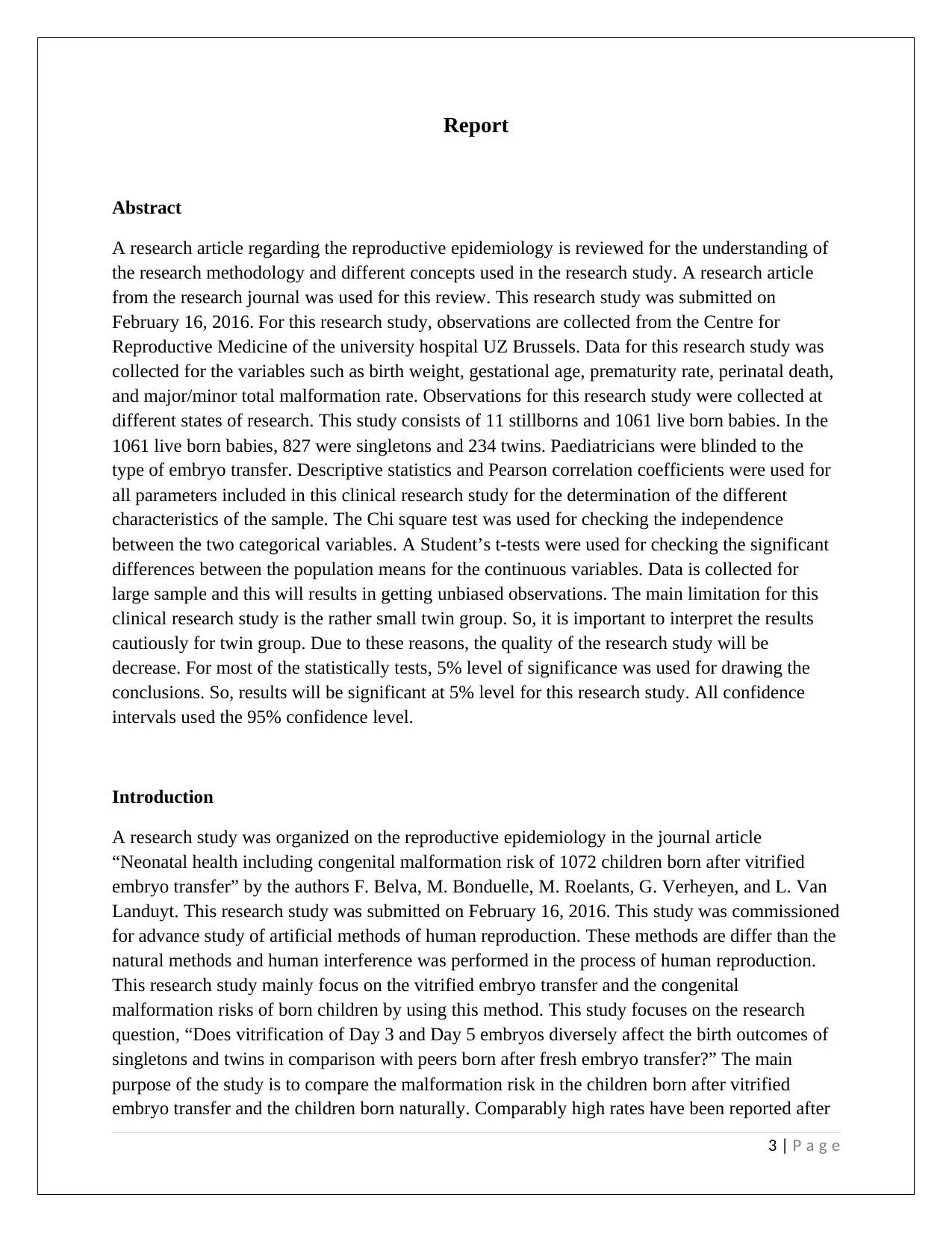
Report
Abstract
A research article regarding the reproductive epidemiology is reviewed for the understanding of
the research methodology and different concepts used in the research study. A research article
from the research journal was used for this review. This research study was submitted on
February 16, 2016. For this research study, observations are collected from the Centre for
Reproductive Medicine of the university hospital UZ Brussels. Data for this research study was
collected for the variables such as birth weight, gestational age, prematurity rate, perinatal death,
and major/minor total malformation rate. Observations for this research study were collected at
different states of research. This study consists of 11 stillborns and 1061 live born babies. In the
1061 live born babies, 827 were singletons and 234 twins. Paediatricians were blinded to the
type of embryo transfer. Descriptive statistics and Pearson correlation coefficients were used for
all parameters included in this clinical research study for the determination of the different
characteristics of the sample. The Chi square test was used for checking the independence
between the two categorical variables. A Student’s t-tests were used for checking the significant
differences between the population means for the continuous variables. Data is collected for
large sample and this will results in getting unbiased observations. The main limitation for this
clinical research study is the rather small twin group. So, it is important to interpret the results
cautiously for twin group. Due to these reasons, the quality of the research study will be
decrease. For most of the statistically tests, 5% level of significance was used for drawing the
conclusions. So, results will be significant at 5% level for this research study. All confidence
intervals used the 95% confidence level.
Introduction
A research study was organized on the reproductive epidemiology in the journal article
“Neonatal health including congenital malformation risk of 1072 children born after vitrified
embryo transfer” by the authors F. Belva, M. Bonduelle, M. Roelants, G. Verheyen, and L. Van
Landuyt. This research study was submitted on February 16, 2016. This study was commissioned
for advance study of artificial methods of human reproduction. These methods are differ than the
natural methods and human interference was performed in the process of human reproduction.
This research study mainly focus on the vitrified embryo transfer and the congenital
malformation risks of born children by using this method. This study focuses on the research
question, “Does vitrification of Day 3 and Day 5 embryos diversely affect the birth outcomes of
singletons and twins in comparison with peers born after fresh embryo transfer?” The main
purpose of the study is to compare the malformation risk in the children born after vitrified
embryo transfer and the children born naturally. Comparably high rates have been reported after
3 | P a g e
Abstract
A research article regarding the reproductive epidemiology is reviewed for the understanding of
the research methodology and different concepts used in the research study. A research article
from the research journal was used for this review. This research study was submitted on
February 16, 2016. For this research study, observations are collected from the Centre for
Reproductive Medicine of the university hospital UZ Brussels. Data for this research study was
collected for the variables such as birth weight, gestational age, prematurity rate, perinatal death,
and major/minor total malformation rate. Observations for this research study were collected at
different states of research. This study consists of 11 stillborns and 1061 live born babies. In the
1061 live born babies, 827 were singletons and 234 twins. Paediatricians were blinded to the
type of embryo transfer. Descriptive statistics and Pearson correlation coefficients were used for
all parameters included in this clinical research study for the determination of the different
characteristics of the sample. The Chi square test was used for checking the independence
between the two categorical variables. A Student’s t-tests were used for checking the significant
differences between the population means for the continuous variables. Data is collected for
large sample and this will results in getting unbiased observations. The main limitation for this
clinical research study is the rather small twin group. So, it is important to interpret the results
cautiously for twin group. Due to these reasons, the quality of the research study will be
decrease. For most of the statistically tests, 5% level of significance was used for drawing the
conclusions. So, results will be significant at 5% level for this research study. All confidence
intervals used the 95% confidence level.
Introduction
A research study was organized on the reproductive epidemiology in the journal article
“Neonatal health including congenital malformation risk of 1072 children born after vitrified
embryo transfer” by the authors F. Belva, M. Bonduelle, M. Roelants, G. Verheyen, and L. Van
Landuyt. This research study was submitted on February 16, 2016. This study was commissioned
for advance study of artificial methods of human reproduction. These methods are differ than the
natural methods and human interference was performed in the process of human reproduction.
This research study mainly focus on the vitrified embryo transfer and the congenital
malformation risks of born children by using this method. This study focuses on the research
question, “Does vitrification of Day 3 and Day 5 embryos diversely affect the birth outcomes of
singletons and twins in comparison with peers born after fresh embryo transfer?” The main
purpose of the study is to compare the malformation risk in the children born after vitrified
embryo transfer and the children born naturally. Comparably high rates have been reported after
3 | P a g e
⊘ This is a preview!⊘
Do you want full access?
Subscribe today to unlock all pages.

Trusted by 1+ million students worldwide
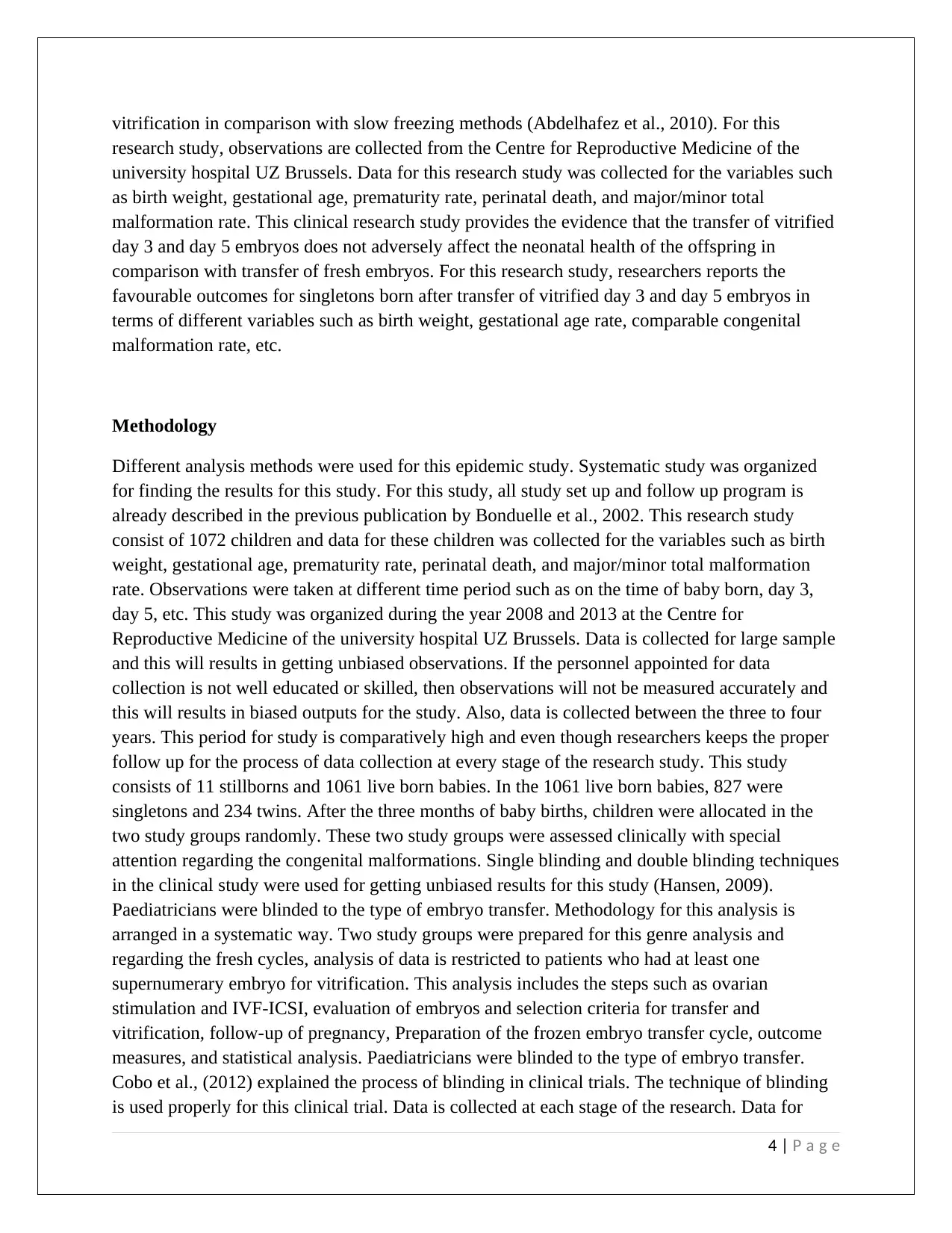
vitrification in comparison with slow freezing methods (Abdelhafez et al., 2010). For this
research study, observations are collected from the Centre for Reproductive Medicine of the
university hospital UZ Brussels. Data for this research study was collected for the variables such
as birth weight, gestational age, prematurity rate, perinatal death, and major/minor total
malformation rate. This clinical research study provides the evidence that the transfer of vitrified
day 3 and day 5 embryos does not adversely affect the neonatal health of the offspring in
comparison with transfer of fresh embryos. For this research study, researchers reports the
favourable outcomes for singletons born after transfer of vitrified day 3 and day 5 embryos in
terms of different variables such as birth weight, gestational age rate, comparable congenital
malformation rate, etc.
Methodology
Different analysis methods were used for this epidemic study. Systematic study was organized
for finding the results for this study. For this study, all study set up and follow up program is
already described in the previous publication by Bonduelle et al., 2002. This research study
consist of 1072 children and data for these children was collected for the variables such as birth
weight, gestational age, prematurity rate, perinatal death, and major/minor total malformation
rate. Observations were taken at different time period such as on the time of baby born, day 3,
day 5, etc. This study was organized during the year 2008 and 2013 at the Centre for
Reproductive Medicine of the university hospital UZ Brussels. Data is collected for large sample
and this will results in getting unbiased observations. If the personnel appointed for data
collection is not well educated or skilled, then observations will not be measured accurately and
this will results in biased outputs for the study. Also, data is collected between the three to four
years. This period for study is comparatively high and even though researchers keeps the proper
follow up for the process of data collection at every stage of the research study. This study
consists of 11 stillborns and 1061 live born babies. In the 1061 live born babies, 827 were
singletons and 234 twins. After the three months of baby births, children were allocated in the
two study groups randomly. These two study groups were assessed clinically with special
attention regarding the congenital malformations. Single blinding and double blinding techniques
in the clinical study were used for getting unbiased results for this study (Hansen, 2009).
Paediatricians were blinded to the type of embryo transfer. Methodology for this analysis is
arranged in a systematic way. Two study groups were prepared for this genre analysis and
regarding the fresh cycles, analysis of data is restricted to patients who had at least one
supernumerary embryo for vitrification. This analysis includes the steps such as ovarian
stimulation and IVF-ICSI, evaluation of embryos and selection criteria for transfer and
vitrification, follow-up of pregnancy, Preparation of the frozen embryo transfer cycle, outcome
measures, and statistical analysis. Paediatricians were blinded to the type of embryo transfer.
Cobo et al., (2012) explained the process of blinding in clinical trials. The technique of blinding
is used properly for this clinical trial. Data is collected at each stage of the research. Data for
4 | P a g e
research study, observations are collected from the Centre for Reproductive Medicine of the
university hospital UZ Brussels. Data for this research study was collected for the variables such
as birth weight, gestational age, prematurity rate, perinatal death, and major/minor total
malformation rate. This clinical research study provides the evidence that the transfer of vitrified
day 3 and day 5 embryos does not adversely affect the neonatal health of the offspring in
comparison with transfer of fresh embryos. For this research study, researchers reports the
favourable outcomes for singletons born after transfer of vitrified day 3 and day 5 embryos in
terms of different variables such as birth weight, gestational age rate, comparable congenital
malformation rate, etc.
Methodology
Different analysis methods were used for this epidemic study. Systematic study was organized
for finding the results for this study. For this study, all study set up and follow up program is
already described in the previous publication by Bonduelle et al., 2002. This research study
consist of 1072 children and data for these children was collected for the variables such as birth
weight, gestational age, prematurity rate, perinatal death, and major/minor total malformation
rate. Observations were taken at different time period such as on the time of baby born, day 3,
day 5, etc. This study was organized during the year 2008 and 2013 at the Centre for
Reproductive Medicine of the university hospital UZ Brussels. Data is collected for large sample
and this will results in getting unbiased observations. If the personnel appointed for data
collection is not well educated or skilled, then observations will not be measured accurately and
this will results in biased outputs for the study. Also, data is collected between the three to four
years. This period for study is comparatively high and even though researchers keeps the proper
follow up for the process of data collection at every stage of the research study. This study
consists of 11 stillborns and 1061 live born babies. In the 1061 live born babies, 827 were
singletons and 234 twins. After the three months of baby births, children were allocated in the
two study groups randomly. These two study groups were assessed clinically with special
attention regarding the congenital malformations. Single blinding and double blinding techniques
in the clinical study were used for getting unbiased results for this study (Hansen, 2009).
Paediatricians were blinded to the type of embryo transfer. Methodology for this analysis is
arranged in a systematic way. Two study groups were prepared for this genre analysis and
regarding the fresh cycles, analysis of data is restricted to patients who had at least one
supernumerary embryo for vitrification. This analysis includes the steps such as ovarian
stimulation and IVF-ICSI, evaluation of embryos and selection criteria for transfer and
vitrification, follow-up of pregnancy, Preparation of the frozen embryo transfer cycle, outcome
measures, and statistical analysis. Paediatricians were blinded to the type of embryo transfer.
Cobo et al., (2012) explained the process of blinding in clinical trials. The technique of blinding
is used properly for this clinical trial. Data is collected at each stage of the research. Data for
4 | P a g e
Paraphrase This Document
Need a fresh take? Get an instant paraphrase of this document with our AI Paraphraser
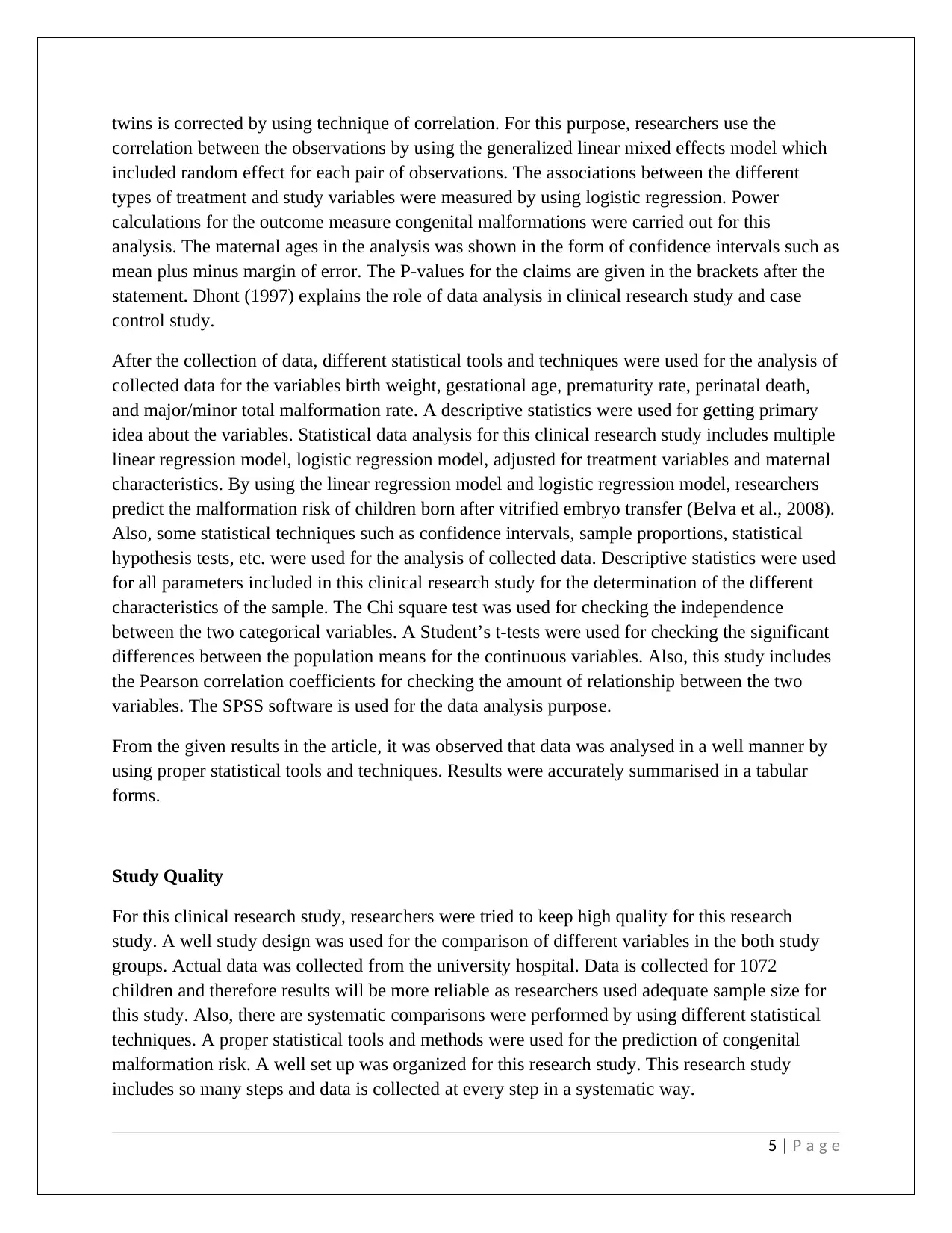
twins is corrected by using technique of correlation. For this purpose, researchers use the
correlation between the observations by using the generalized linear mixed effects model which
included random effect for each pair of observations. The associations between the different
types of treatment and study variables were measured by using logistic regression. Power
calculations for the outcome measure congenital malformations were carried out for this
analysis. The maternal ages in the analysis was shown in the form of confidence intervals such as
mean plus minus margin of error. The P-values for the claims are given in the brackets after the
statement. Dhont (1997) explains the role of data analysis in clinical research study and case
control study.
After the collection of data, different statistical tools and techniques were used for the analysis of
collected data for the variables birth weight, gestational age, prematurity rate, perinatal death,
and major/minor total malformation rate. A descriptive statistics were used for getting primary
idea about the variables. Statistical data analysis for this clinical research study includes multiple
linear regression model, logistic regression model, adjusted for treatment variables and maternal
characteristics. By using the linear regression model and logistic regression model, researchers
predict the malformation risk of children born after vitrified embryo transfer (Belva et al., 2008).
Also, some statistical techniques such as confidence intervals, sample proportions, statistical
hypothesis tests, etc. were used for the analysis of collected data. Descriptive statistics were used
for all parameters included in this clinical research study for the determination of the different
characteristics of the sample. The Chi square test was used for checking the independence
between the two categorical variables. A Student’s t-tests were used for checking the significant
differences between the population means for the continuous variables. Also, this study includes
the Pearson correlation coefficients for checking the amount of relationship between the two
variables. The SPSS software is used for the data analysis purpose.
From the given results in the article, it was observed that data was analysed in a well manner by
using proper statistical tools and techniques. Results were accurately summarised in a tabular
forms.
Study Quality
For this clinical research study, researchers were tried to keep high quality for this research
study. A well study design was used for the comparison of different variables in the both study
groups. Actual data was collected from the university hospital. Data is collected for 1072
children and therefore results will be more reliable as researchers used adequate sample size for
this study. Also, there are systematic comparisons were performed by using different statistical
techniques. A proper statistical tools and methods were used for the prediction of congenital
malformation risk. A well set up was organized for this research study. This research study
includes so many steps and data is collected at every step in a systematic way.
5 | P a g e
correlation between the observations by using the generalized linear mixed effects model which
included random effect for each pair of observations. The associations between the different
types of treatment and study variables were measured by using logistic regression. Power
calculations for the outcome measure congenital malformations were carried out for this
analysis. The maternal ages in the analysis was shown in the form of confidence intervals such as
mean plus minus margin of error. The P-values for the claims are given in the brackets after the
statement. Dhont (1997) explains the role of data analysis in clinical research study and case
control study.
After the collection of data, different statistical tools and techniques were used for the analysis of
collected data for the variables birth weight, gestational age, prematurity rate, perinatal death,
and major/minor total malformation rate. A descriptive statistics were used for getting primary
idea about the variables. Statistical data analysis for this clinical research study includes multiple
linear regression model, logistic regression model, adjusted for treatment variables and maternal
characteristics. By using the linear regression model and logistic regression model, researchers
predict the malformation risk of children born after vitrified embryo transfer (Belva et al., 2008).
Also, some statistical techniques such as confidence intervals, sample proportions, statistical
hypothesis tests, etc. were used for the analysis of collected data. Descriptive statistics were used
for all parameters included in this clinical research study for the determination of the different
characteristics of the sample. The Chi square test was used for checking the independence
between the two categorical variables. A Student’s t-tests were used for checking the significant
differences between the population means for the continuous variables. Also, this study includes
the Pearson correlation coefficients for checking the amount of relationship between the two
variables. The SPSS software is used for the data analysis purpose.
From the given results in the article, it was observed that data was analysed in a well manner by
using proper statistical tools and techniques. Results were accurately summarised in a tabular
forms.
Study Quality
For this clinical research study, researchers were tried to keep high quality for this research
study. A well study design was used for the comparison of different variables in the both study
groups. Actual data was collected from the university hospital. Data is collected for 1072
children and therefore results will be more reliable as researchers used adequate sample size for
this study. Also, there are systematic comparisons were performed by using different statistical
techniques. A proper statistical tools and methods were used for the prediction of congenital
malformation risk. A well set up was organized for this research study. This research study
includes so many steps and data is collected at every step in a systematic way.
5 | P a g e
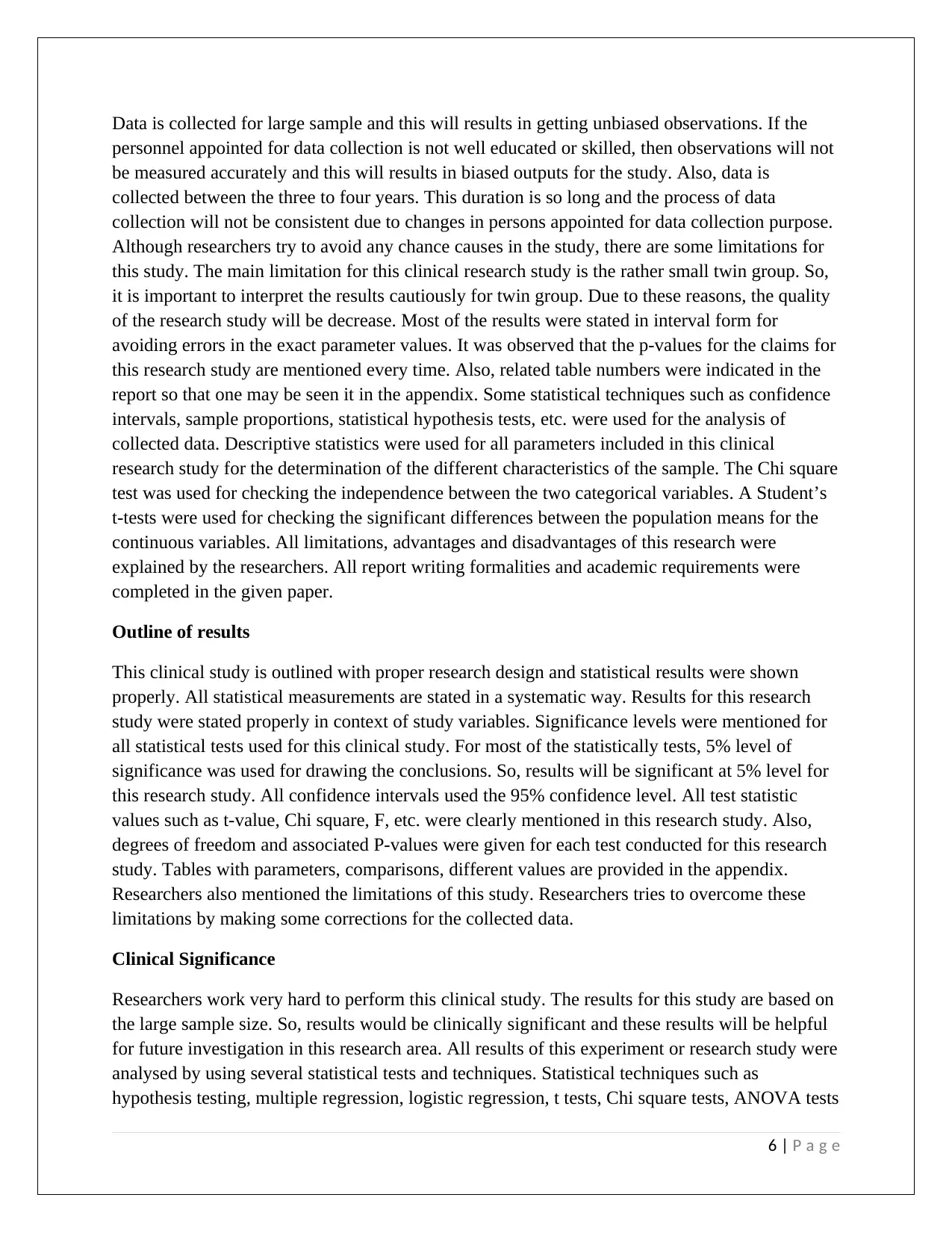
Data is collected for large sample and this will results in getting unbiased observations. If the
personnel appointed for data collection is not well educated or skilled, then observations will not
be measured accurately and this will results in biased outputs for the study. Also, data is
collected between the three to four years. This duration is so long and the process of data
collection will not be consistent due to changes in persons appointed for data collection purpose.
Although researchers try to avoid any chance causes in the study, there are some limitations for
this study. The main limitation for this clinical research study is the rather small twin group. So,
it is important to interpret the results cautiously for twin group. Due to these reasons, the quality
of the research study will be decrease. Most of the results were stated in interval form for
avoiding errors in the exact parameter values. It was observed that the p-values for the claims for
this research study are mentioned every time. Also, related table numbers were indicated in the
report so that one may be seen it in the appendix. Some statistical techniques such as confidence
intervals, sample proportions, statistical hypothesis tests, etc. were used for the analysis of
collected data. Descriptive statistics were used for all parameters included in this clinical
research study for the determination of the different characteristics of the sample. The Chi square
test was used for checking the independence between the two categorical variables. A Student’s
t-tests were used for checking the significant differences between the population means for the
continuous variables. All limitations, advantages and disadvantages of this research were
explained by the researchers. All report writing formalities and academic requirements were
completed in the given paper.
Outline of results
This clinical study is outlined with proper research design and statistical results were shown
properly. All statistical measurements are stated in a systematic way. Results for this research
study were stated properly in context of study variables. Significance levels were mentioned for
all statistical tests used for this clinical study. For most of the statistically tests, 5% level of
significance was used for drawing the conclusions. So, results will be significant at 5% level for
this research study. All confidence intervals used the 95% confidence level. All test statistic
values such as t-value, Chi square, F, etc. were clearly mentioned in this research study. Also,
degrees of freedom and associated P-values were given for each test conducted for this research
study. Tables with parameters, comparisons, different values are provided in the appendix.
Researchers also mentioned the limitations of this study. Researchers tries to overcome these
limitations by making some corrections for the collected data.
Clinical Significance
Researchers work very hard to perform this clinical study. The results for this study are based on
the large sample size. So, results would be clinically significant and these results will be helpful
for future investigation in this research area. All results of this experiment or research study were
analysed by using several statistical tests and techniques. Statistical techniques such as
hypothesis testing, multiple regression, logistic regression, t tests, Chi square tests, ANOVA tests
6 | P a g e
personnel appointed for data collection is not well educated or skilled, then observations will not
be measured accurately and this will results in biased outputs for the study. Also, data is
collected between the three to four years. This duration is so long and the process of data
collection will not be consistent due to changes in persons appointed for data collection purpose.
Although researchers try to avoid any chance causes in the study, there are some limitations for
this study. The main limitation for this clinical research study is the rather small twin group. So,
it is important to interpret the results cautiously for twin group. Due to these reasons, the quality
of the research study will be decrease. Most of the results were stated in interval form for
avoiding errors in the exact parameter values. It was observed that the p-values for the claims for
this research study are mentioned every time. Also, related table numbers were indicated in the
report so that one may be seen it in the appendix. Some statistical techniques such as confidence
intervals, sample proportions, statistical hypothesis tests, etc. were used for the analysis of
collected data. Descriptive statistics were used for all parameters included in this clinical
research study for the determination of the different characteristics of the sample. The Chi square
test was used for checking the independence between the two categorical variables. A Student’s
t-tests were used for checking the significant differences between the population means for the
continuous variables. All limitations, advantages and disadvantages of this research were
explained by the researchers. All report writing formalities and academic requirements were
completed in the given paper.
Outline of results
This clinical study is outlined with proper research design and statistical results were shown
properly. All statistical measurements are stated in a systematic way. Results for this research
study were stated properly in context of study variables. Significance levels were mentioned for
all statistical tests used for this clinical study. For most of the statistically tests, 5% level of
significance was used for drawing the conclusions. So, results will be significant at 5% level for
this research study. All confidence intervals used the 95% confidence level. All test statistic
values such as t-value, Chi square, F, etc. were clearly mentioned in this research study. Also,
degrees of freedom and associated P-values were given for each test conducted for this research
study. Tables with parameters, comparisons, different values are provided in the appendix.
Researchers also mentioned the limitations of this study. Researchers tries to overcome these
limitations by making some corrections for the collected data.
Clinical Significance
Researchers work very hard to perform this clinical study. The results for this study are based on
the large sample size. So, results would be clinically significant and these results will be helpful
for future investigation in this research area. All results of this experiment or research study were
analysed by using several statistical tests and techniques. Statistical techniques such as
hypothesis testing, multiple regression, logistic regression, t tests, Chi square tests, ANOVA tests
6 | P a g e
⊘ This is a preview!⊘
Do you want full access?
Subscribe today to unlock all pages.

Trusted by 1+ million students worldwide
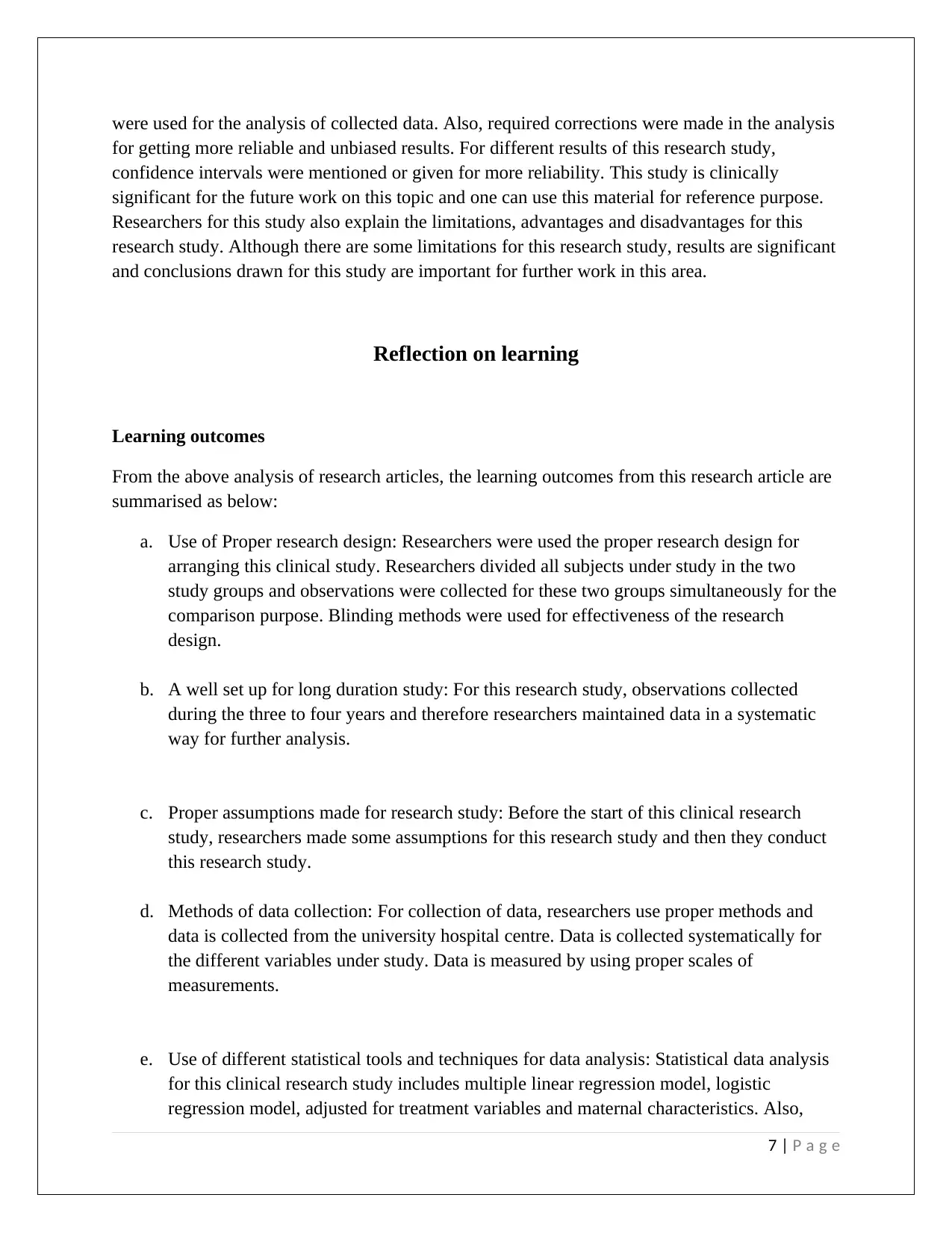
were used for the analysis of collected data. Also, required corrections were made in the analysis
for getting more reliable and unbiased results. For different results of this research study,
confidence intervals were mentioned or given for more reliability. This study is clinically
significant for the future work on this topic and one can use this material for reference purpose.
Researchers for this study also explain the limitations, advantages and disadvantages for this
research study. Although there are some limitations for this research study, results are significant
and conclusions drawn for this study are important for further work in this area.
Reflection on learning
Learning outcomes
From the above analysis of research articles, the learning outcomes from this research article are
summarised as below:
a. Use of Proper research design: Researchers were used the proper research design for
arranging this clinical study. Researchers divided all subjects under study in the two
study groups and observations were collected for these two groups simultaneously for the
comparison purpose. Blinding methods were used for effectiveness of the research
design.
b. A well set up for long duration study: For this research study, observations collected
during the three to four years and therefore researchers maintained data in a systematic
way for further analysis.
c. Proper assumptions made for research study: Before the start of this clinical research
study, researchers made some assumptions for this research study and then they conduct
this research study.
d. Methods of data collection: For collection of data, researchers use proper methods and
data is collected from the university hospital centre. Data is collected systematically for
the different variables under study. Data is measured by using proper scales of
measurements.
e. Use of different statistical tools and techniques for data analysis: Statistical data analysis
for this clinical research study includes multiple linear regression model, logistic
regression model, adjusted for treatment variables and maternal characteristics. Also,
7 | P a g e
for getting more reliable and unbiased results. For different results of this research study,
confidence intervals were mentioned or given for more reliability. This study is clinically
significant for the future work on this topic and one can use this material for reference purpose.
Researchers for this study also explain the limitations, advantages and disadvantages for this
research study. Although there are some limitations for this research study, results are significant
and conclusions drawn for this study are important for further work in this area.
Reflection on learning
Learning outcomes
From the above analysis of research articles, the learning outcomes from this research article are
summarised as below:
a. Use of Proper research design: Researchers were used the proper research design for
arranging this clinical study. Researchers divided all subjects under study in the two
study groups and observations were collected for these two groups simultaneously for the
comparison purpose. Blinding methods were used for effectiveness of the research
design.
b. A well set up for long duration study: For this research study, observations collected
during the three to four years and therefore researchers maintained data in a systematic
way for further analysis.
c. Proper assumptions made for research study: Before the start of this clinical research
study, researchers made some assumptions for this research study and then they conduct
this research study.
d. Methods of data collection: For collection of data, researchers use proper methods and
data is collected from the university hospital centre. Data is collected systematically for
the different variables under study. Data is measured by using proper scales of
measurements.
e. Use of different statistical tools and techniques for data analysis: Statistical data analysis
for this clinical research study includes multiple linear regression model, logistic
regression model, adjusted for treatment variables and maternal characteristics. Also,
7 | P a g e
Paraphrase This Document
Need a fresh take? Get an instant paraphrase of this document with our AI Paraphraser
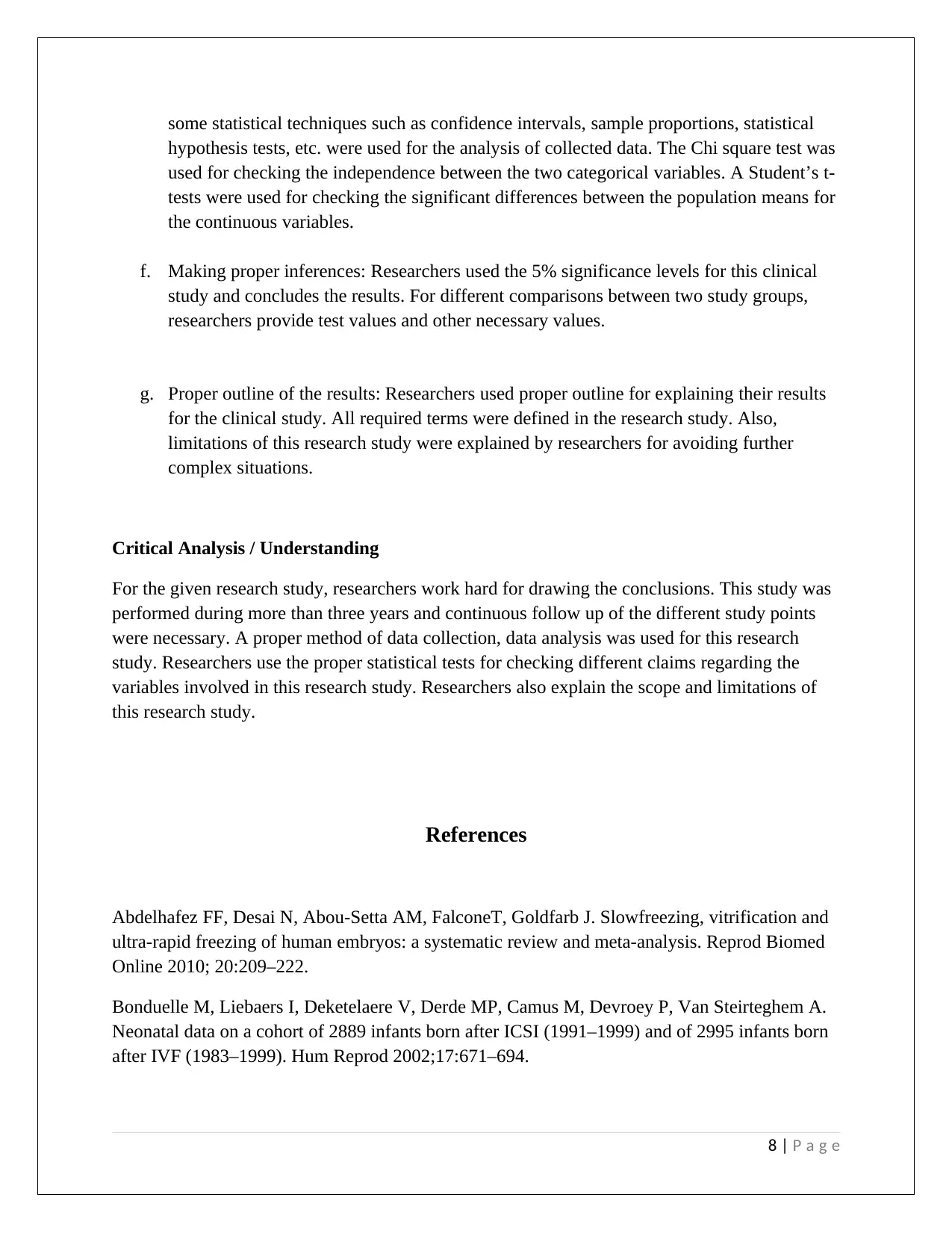
some statistical techniques such as confidence intervals, sample proportions, statistical
hypothesis tests, etc. were used for the analysis of collected data. The Chi square test was
used for checking the independence between the two categorical variables. A Student’s t-
tests were used for checking the significant differences between the population means for
the continuous variables.
f. Making proper inferences: Researchers used the 5% significance levels for this clinical
study and concludes the results. For different comparisons between two study groups,
researchers provide test values and other necessary values.
g. Proper outline of the results: Researchers used proper outline for explaining their results
for the clinical study. All required terms were defined in the research study. Also,
limitations of this research study were explained by researchers for avoiding further
complex situations.
Critical Analysis / Understanding
For the given research study, researchers work hard for drawing the conclusions. This study was
performed during more than three years and continuous follow up of the different study points
were necessary. A proper method of data collection, data analysis was used for this research
study. Researchers use the proper statistical tests for checking different claims regarding the
variables involved in this research study. Researchers also explain the scope and limitations of
this research study.
References
Abdelhafez FF, Desai N, Abou-Setta AM, FalconeT, Goldfarb J. Slowfreezing, vitrification and
ultra-rapid freezing of human embryos: a systematic review and meta-analysis. Reprod Biomed
Online 2010; 20:209–222.
Bonduelle M, Liebaers I, Deketelaere V, Derde MP, Camus M, Devroey P, Van Steirteghem A.
Neonatal data on a cohort of 2889 infants born after ICSI (1991–1999) and of 2995 infants born
after IVF (1983–1999). Hum Reprod 2002;17:671–694.
8 | P a g e
hypothesis tests, etc. were used for the analysis of collected data. The Chi square test was
used for checking the independence between the two categorical variables. A Student’s t-
tests were used for checking the significant differences between the population means for
the continuous variables.
f. Making proper inferences: Researchers used the 5% significance levels for this clinical
study and concludes the results. For different comparisons between two study groups,
researchers provide test values and other necessary values.
g. Proper outline of the results: Researchers used proper outline for explaining their results
for the clinical study. All required terms were defined in the research study. Also,
limitations of this research study were explained by researchers for avoiding further
complex situations.
Critical Analysis / Understanding
For the given research study, researchers work hard for drawing the conclusions. This study was
performed during more than three years and continuous follow up of the different study points
were necessary. A proper method of data collection, data analysis was used for this research
study. Researchers use the proper statistical tests for checking different claims regarding the
variables involved in this research study. Researchers also explain the scope and limitations of
this research study.
References
Abdelhafez FF, Desai N, Abou-Setta AM, FalconeT, Goldfarb J. Slowfreezing, vitrification and
ultra-rapid freezing of human embryos: a systematic review and meta-analysis. Reprod Biomed
Online 2010; 20:209–222.
Bonduelle M, Liebaers I, Deketelaere V, Derde MP, Camus M, Devroey P, Van Steirteghem A.
Neonatal data on a cohort of 2889 infants born after ICSI (1991–1999) and of 2995 infants born
after IVF (1983–1999). Hum Reprod 2002;17:671–694.
8 | P a g e
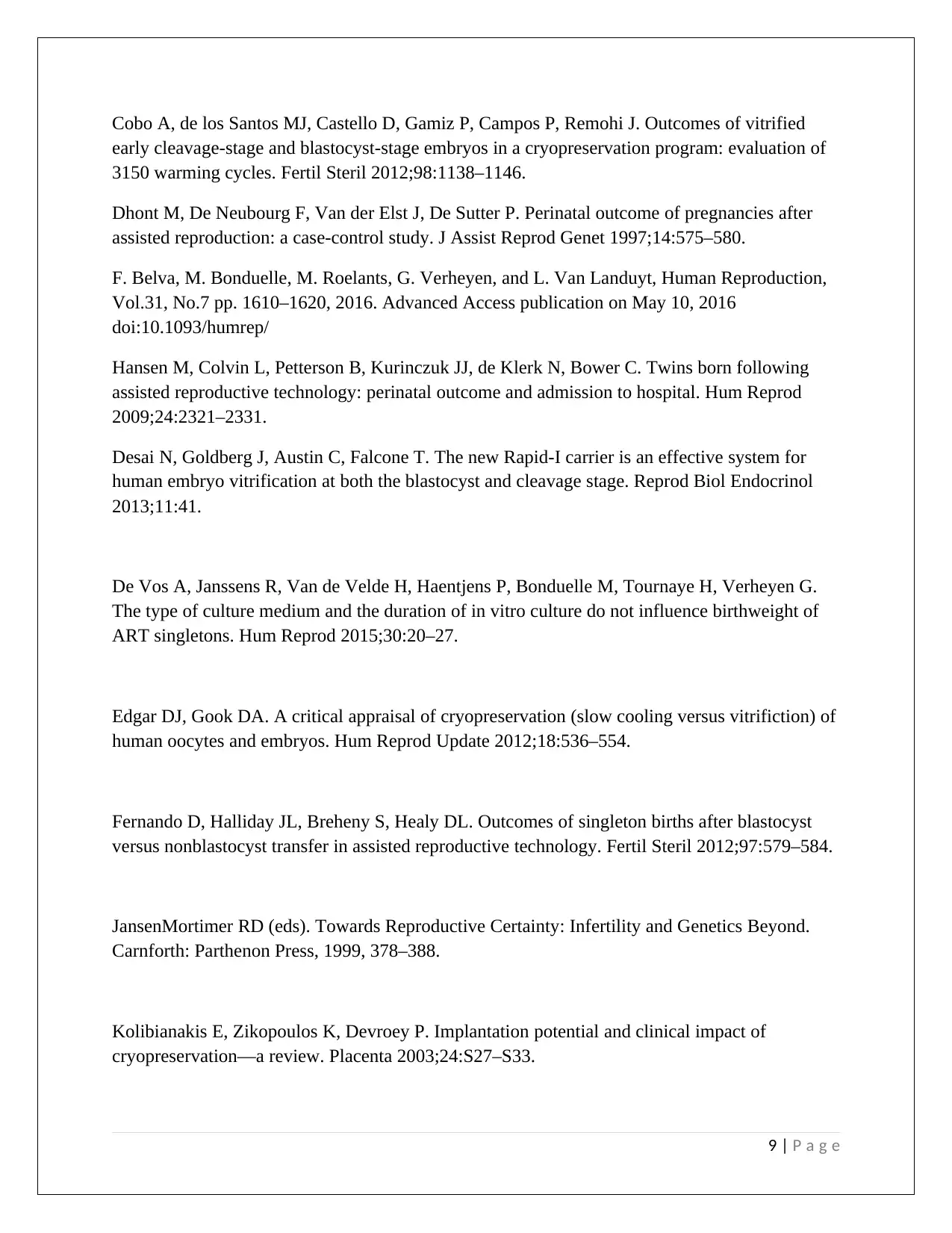
Cobo A, de los Santos MJ, Castello D, Gamiz P, Campos P, Remohi J. Outcomes of vitrified
early cleavage-stage and blastocyst-stage embryos in a cryopreservation program: evaluation of
3150 warming cycles. Fertil Steril 2012;98:1138–1146.
Dhont M, De Neubourg F, Van der Elst J, De Sutter P. Perinatal outcome of pregnancies after
assisted reproduction: a case-control study. J Assist Reprod Genet 1997;14:575–580.
F. Belva, M. Bonduelle, M. Roelants, G. Verheyen, and L. Van Landuyt, Human Reproduction,
Vol.31, No.7 pp. 1610–1620, 2016. Advanced Access publication on May 10, 2016
doi:10.1093/humrep/
Hansen M, Colvin L, Petterson B, Kurinczuk JJ, de Klerk N, Bower C. Twins born following
assisted reproductive technology: perinatal outcome and admission to hospital. Hum Reprod
2009;24:2321–2331.
Desai N, Goldberg J, Austin C, Falcone T. The new Rapid-I carrier is an effective system for
human embryo vitrification at both the blastocyst and cleavage stage. Reprod Biol Endocrinol
2013;11:41.
De Vos A, Janssens R, Van de Velde H, Haentjens P, Bonduelle M, Tournaye H, Verheyen G.
The type of culture medium and the duration of in vitro culture do not influence birthweight of
ART singletons. Hum Reprod 2015;30:20–27.
Edgar DJ, Gook DA. A critical appraisal of cryopreservation (slow cooling versus vitrifiction) of
human oocytes and embryos. Hum Reprod Update 2012;18:536–554.
Fernando D, Halliday JL, Breheny S, Healy DL. Outcomes of singleton births after blastocyst
versus nonblastocyst transfer in assisted reproductive technology. Fertil Steril 2012;97:579–584.
JansenMortimer RD (eds). Towards Reproductive Certainty: Infertility and Genetics Beyond.
Carnforth: Parthenon Press, 1999, 378–388.
Kolibianakis E, Zikopoulos K, Devroey P. Implantation potential and clinical impact of
cryopreservation—a review. Placenta 2003;24:S27–S33.
9 | P a g e
early cleavage-stage and blastocyst-stage embryos in a cryopreservation program: evaluation of
3150 warming cycles. Fertil Steril 2012;98:1138–1146.
Dhont M, De Neubourg F, Van der Elst J, De Sutter P. Perinatal outcome of pregnancies after
assisted reproduction: a case-control study. J Assist Reprod Genet 1997;14:575–580.
F. Belva, M. Bonduelle, M. Roelants, G. Verheyen, and L. Van Landuyt, Human Reproduction,
Vol.31, No.7 pp. 1610–1620, 2016. Advanced Access publication on May 10, 2016
doi:10.1093/humrep/
Hansen M, Colvin L, Petterson B, Kurinczuk JJ, de Klerk N, Bower C. Twins born following
assisted reproductive technology: perinatal outcome and admission to hospital. Hum Reprod
2009;24:2321–2331.
Desai N, Goldberg J, Austin C, Falcone T. The new Rapid-I carrier is an effective system for
human embryo vitrification at both the blastocyst and cleavage stage. Reprod Biol Endocrinol
2013;11:41.
De Vos A, Janssens R, Van de Velde H, Haentjens P, Bonduelle M, Tournaye H, Verheyen G.
The type of culture medium and the duration of in vitro culture do not influence birthweight of
ART singletons. Hum Reprod 2015;30:20–27.
Edgar DJ, Gook DA. A critical appraisal of cryopreservation (slow cooling versus vitrifiction) of
human oocytes and embryos. Hum Reprod Update 2012;18:536–554.
Fernando D, Halliday JL, Breheny S, Healy DL. Outcomes of singleton births after blastocyst
versus nonblastocyst transfer in assisted reproductive technology. Fertil Steril 2012;97:579–584.
JansenMortimer RD (eds). Towards Reproductive Certainty: Infertility and Genetics Beyond.
Carnforth: Parthenon Press, 1999, 378–388.
Kolibianakis E, Zikopoulos K, Devroey P. Implantation potential and clinical impact of
cryopreservation—a review. Placenta 2003;24:S27–S33.
9 | P a g e
⊘ This is a preview!⊘
Do you want full access?
Subscribe today to unlock all pages.

Trusted by 1+ million students worldwide

Kuwayama M, Vajta G, Kato O, Leibo SP. Highly efficient vitrification method for
cryopreservation of human oocytes. Reprod Biomed Online 2005; 11:300–308.
Niklasson A, Albertsson-Wikland K. Continuous growth reference from the 24th week of
gestation to 24 months by gender. BMC Pediatr 2008;8:8.
Appendix
10 | P a g e
cryopreservation of human oocytes. Reprod Biomed Online 2005; 11:300–308.
Niklasson A, Albertsson-Wikland K. Continuous growth reference from the 24th week of
gestation to 24 months by gender. BMC Pediatr 2008;8:8.
Appendix
10 | P a g e
Paraphrase This Document
Need a fresh take? Get an instant paraphrase of this document with our AI Paraphraser
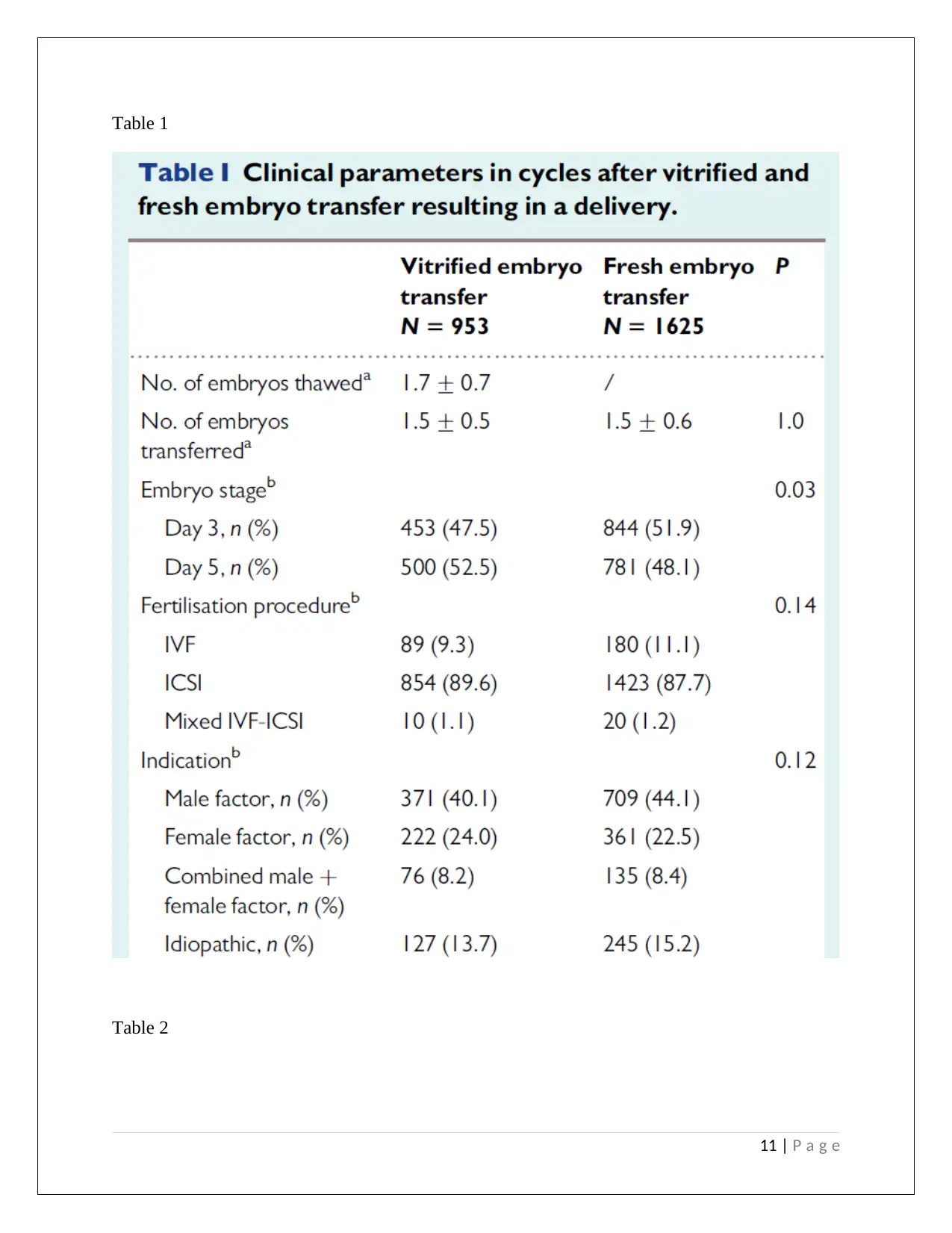
Table 1
Table 2
11 | P a g e
Table 2
11 | P a g e
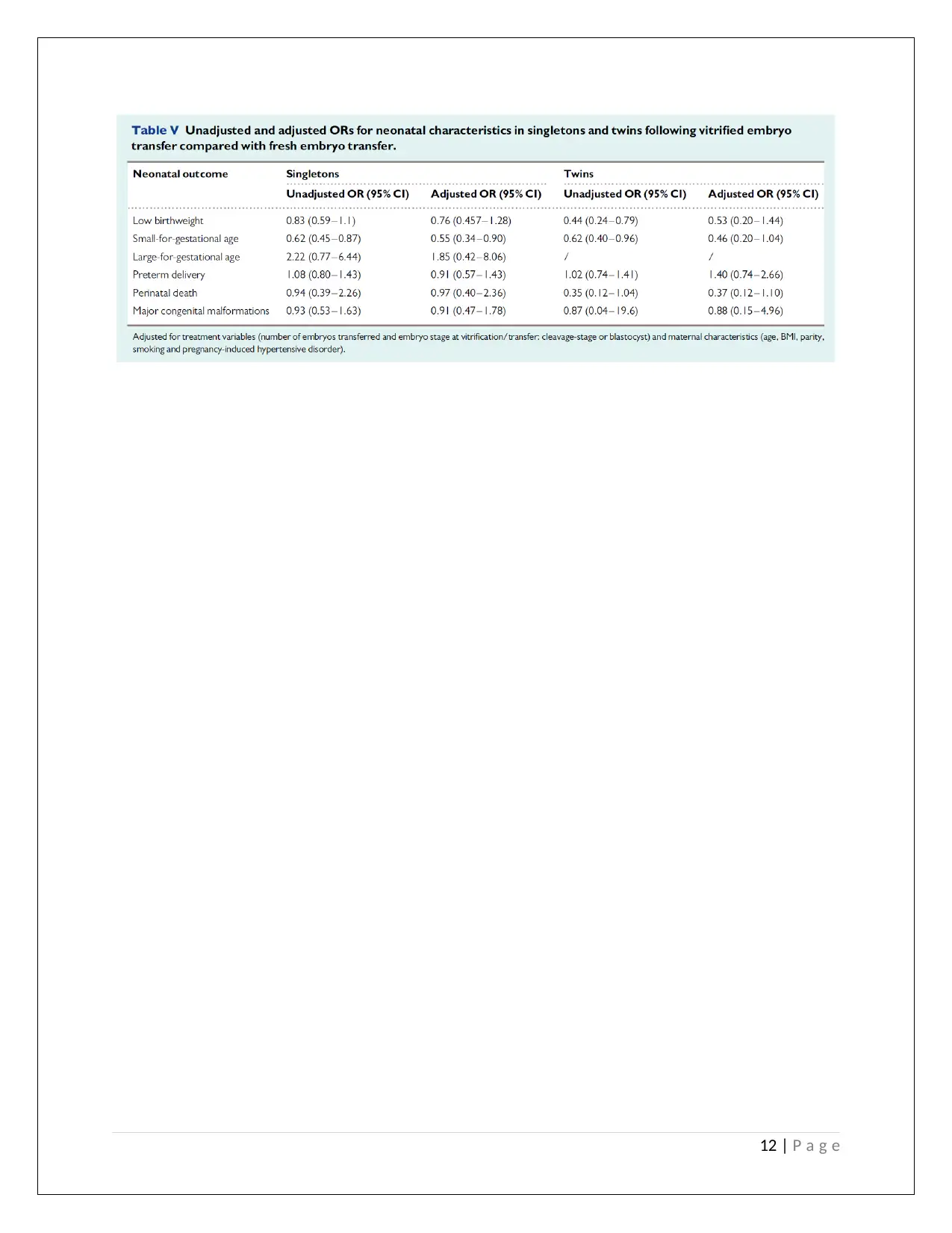
12 | P a g e
⊘ This is a preview!⊘
Do you want full access?
Subscribe today to unlock all pages.

Trusted by 1+ million students worldwide
1 out of 12
Related Documents
Your All-in-One AI-Powered Toolkit for Academic Success.
+13062052269
info@desklib.com
Available 24*7 on WhatsApp / Email
![[object Object]](/_next/static/media/star-bottom.7253800d.svg)
Unlock your academic potential
Copyright © 2020–2025 A2Z Services. All Rights Reserved. Developed and managed by ZUCOL.



